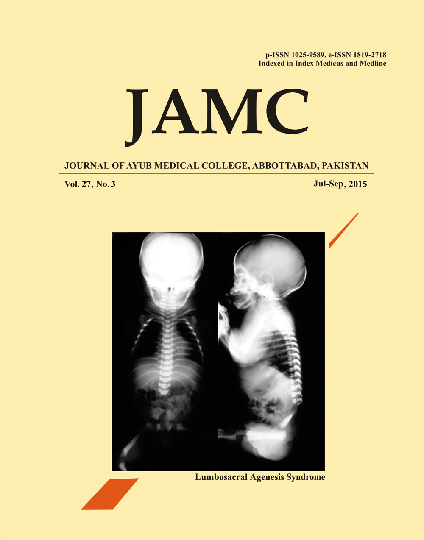LAPAROTOMY FOR PERITONITIS: PRIMARY OR DELAYED PRIMARY CLOSURE?
Abstract
Background: Although literature does not provide a level-1 evidence to support either method of closure, various studies have shown a reduced frequency of superficial surgical site infection with delayed primary closure (DPC) as opposed to primary closure (PC). Nevertheless, PC is still preferred by most surgeons to avoid a second procedure. This study was conducted with the objective to compare the frequency of wound infection and duration of hospitalization among patients undergoing primary and delayed primary closure of the skin wound following laparotomy for peritonitis. Methods: A randomized controlled trial comprising 70 patients: Thirty-five patients underwent PC (Group-A) and 35 DPC (Group-B). Frequency of wound infection during follow up period and duration of hospital stay was noted in both groups. Results: In group-A, 18 (51.43%) patients showed wound infection while in group-B, it was 9 (25.71%) with p=0.027. Mean hospital stay recorded in group-A was 7.03 days±1.81, and for group-B, it was 6.34 days±4.14 (p=0.372). Conclusion: DPC for surgical wounds is better than PC technique as it decreases the frequency of wound infection during follow-up period without any significant increase in duration of hospital stay.References
Mishra SP, Tiwary SK, Mishra M, Gupta SK. An introduction of tertiary peritonitis. J Emerg Trauma Shock 2014;7(2):121–3.
Platell C, Papadimitriou JM, Hall JC. The influence of lavage on peritonitis. J Am Coll Surg 2000;191(6):672–80.
Duttaroy DD, Jitendra J, Duttaroy B, Bansal U, Dhameja P, Patel G, et al. Management strategy for dirty abdominal incisions: primary or delayed primary closure? A Randomized Trial. Surg Infect 2009;10(2):129–36.
Verdam FJ, Dolmans DE, Loos MJ, Raber MH, de Wit RJ, Charbon JA, et al. Delayed primary closure of the septic open abdomen with a dynamic closure system. World J Surgery 2011;35(10):2348–55.
Siribumrungwonga B, Srikueaa K, Thakkinstian A. Comparison of superficial surgical site infection between delayed primary and primary wound closures in ruptured appendicitis. Asian J Surg 2013;37(3):120–4.
Bhangu A, Singh P, Lundy J, Bowley DM. Systemic review and meta-analysis of randomized clinical trials comparing primary vs delayed primary skin closure in contaminated and dirty abdominal incisions. JAMA Surg 2013;148(8):779–86.
Pearl ML, Rayburn WF. Choosing abdominal incision and closure techniques: a review. J Reprod Med 2004;49(8):662–70.
Malangoni MA, Inui T. Peritonitis – the Western experience. World J Emerg Surg 2006;1:25.
Gupta S, Kaushik R. Peritonitis – the Eastern experience. World J Emerg Surg 2006;1:13.
Mehrabi Bahar M, Jangjoo A, Amouzeshi A, Kavianifar K. Wound infection incidence in patients with simple and gangrenous or perforated appendicitis. Arch Iran Med 2010;13(1):13–6.
Anis A, Muhammad H, Yasmeen I. A comparison of primary closure versus delayed primary closure in contaminated. abdominal surgery in terms of surgical site infection. JPMI 2013;27(4):403–8.
Usang UE, Sowande OA, Ademuyiwa AO, Bakare TI, Adejuyigbe O. Outcome of primary closure of abdominal wounds following typhoid perforation in children in Ile-Ife, Nigeria. Afr J Paediatr Surg 2009;6(1):31–4.
Bender JS. Factors influencing outcome in delayed primary closure of contaminated abdominal wounds: a prospective analysis of 181 consecutive patients. Am Surg 2003;69(3):252–5.
Cohn SM, Giannotti G, Ong AW, Varela JE, Shatz DV, McKenney MG, et al. Prospective randomized trial of two wound management strategies for dirty abdominal wounds. Ann Surg 2001;233(3):409–13.
Published
Issue
Section
License
Journal of Ayub Medical College, Abbottabad is an OPEN ACCESS JOURNAL which means that all content is FREELY available without charge to all users whether registered with the journal or not. The work published by J Ayub Med Coll Abbottabad is licensed and distributed under the creative commons License CC BY ND Attribution-NoDerivs. Material printed in this journal is OPEN to access, and are FREE for use in academic and research work with proper citation. J Ayub Med Coll Abbottabad accepts only original material for publication with the understanding that except for abstracts, no part of the data has been published or will be submitted for publication elsewhere before appearing in J Ayub Med Coll Abbottabad. The Editorial Board of J Ayub Med Coll Abbottabad makes every effort to ensure the accuracy and authenticity of material printed in J Ayub Med Coll Abbottabad. However, conclusions and statements expressed are views of the authors and do not reflect the opinion/policy of J Ayub Med Coll Abbottabad or the Editorial Board.
USERS are allowed to read, download, copy, distribute, print, search, or link to the full texts of the articles, or use them for any other lawful purpose, without asking prior permission from the publisher or the author. This is in accordance with the BOAI definition of open access.
AUTHORS retain the rights of free downloading/unlimited e-print of full text and sharing/disseminating the article without any restriction, by any means including twitter, scholarly collaboration networks such as ResearchGate, Academia.eu, and social media sites such as Twitter, LinkedIn, Google Scholar and any other professional or academic networking site.









